Energetics And Food Therapy For Pets
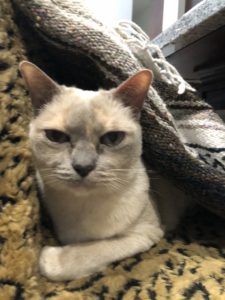
Lili
I had the opportunity to watch some great presentations on the Animal Wellness Summit this week! It’s a web-based platform where holistic health experts and veterinarians present talks and videos on a variety of topics pertaining to pets. One of the lectures I watched was by presented Dr. Judy Morgan, an integrative, holistic veterinarian, and she discussed the energetics of food. Proper nutrition is fundamental to our pets’ health, but have you ever considered how different foods affect our pets? The kinds of food we feed our pets can have a direct affect on an animal’s condition. Here are some fascinating things I learned about food therapy for pets.
What is food therapy for pets?
Food therapy for pets is rooted in traditional Chinese medicine, or TCM, and explores how different kinds of food affects the body in different ways. Eastern medicine focuses on energy balance or what is more commonly known as yin and yang. These energies won’t always be 50-50, but you don’t want all of one and none of the other. It takes both to be complete. Let’s take a closer look at these two energetics.
Yin characteristics include:
- cooling
- moisturizing
- female
- dark
- inside
- down
- calm
- slow
Yang characteristics include:
- warm or hot
- movement
- energy
- male
- light
- dry
- up
The energetics of food
Not all foods are created equal in terms of energetics. Foods that are more processed and heated to very high temperatures can have a warming effect on the body. A good example would be kibble. Canned and homemade cooked diets don’t require such high temperatures, and therefore, are not considered as warm on the body. Freeze-dried, frozen or fresh raw food would be cooler and promote a more cooling effect on the body.
The charts below show examples of Yang, Yin and Neutral foods. While all of these wouldn’t obviously be appropriate for pets, they give you an idea of how certain foods, spices, and fats affect the body energetically.

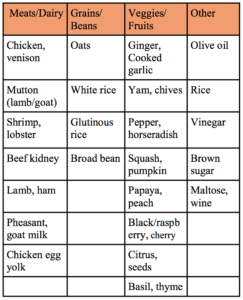
Image credit: The Lightfoot Way
Warm foods are used when a pet exhibits signs of being cold or when they need their energy boosted.
Be sure to watch for signs of too much heat.
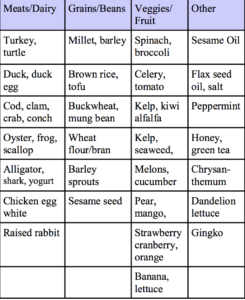
Image credit: The Lightfoot Way
Yin foods are used when a pet is too hot, has a medical condition that causes their body to run high, or to calm energy.
Watch out for signs of being too cold.
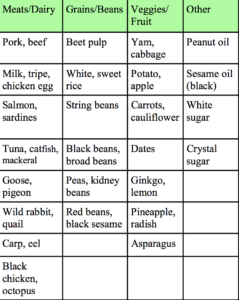
Image credit: The Lightfoot Way
Neutral foods are fine for pets with no health conditions, pets who don’t exhibits symptoms of heat or cold,
or pets with normal activity/energy levels.
Ways to apply food therapy for pets
There are many ways to approach food therapy with pets. Dr. Morgan’s examples were fascinating to me, and they made me think of the relationship between food and conditions in a way I’ve never thought of before. Here are some considerations as you think about which foods would benefit a particular condition:
- Tongue color. If an animal’s tongue is very red it indicates heat; light pink would be cool.
- Thirst. An animal that drinks a lot of water is trying to trying to cool itself down because its body heat is running high.
- Panting. Animals don’t sweat; therefore, they lose heat and cool off through their paws and by panting.
- Sleeping patterns. Does your pet prefer to sleep under the covers or blankets or a cold, hard surface?
- Energy level. Does your pet resemble a couch potato or the Energizer bunny? The lazy animal is cooler, and the high energy one is warm/hot.
- Age. Younger pets tend to have a lot more energy while older pets tend to be more laid back and sleep more.
- Breed. Some breeds are naturally more energetic while others are calm.
- Nose and paw pads. Do your pet’s nose and paw pads tend to feel more cool or warm?
- Coat color. Even coat colors can express cooler (dark) or warmer (light) energy.
- Favorite season. What is your pet’s favorite season? Do they love sunbathing in 95 degree weather or romping in the snow?
- Choice of food. If given a choice, which foods does your pet tend to select? Do they prefer a raw meaty bone, fresh fruits, canned, or cooked food?
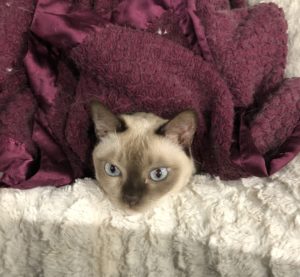
Rocket loves to sleep under the blanket
Food therapy and cats
Several of these examples made me think of my own cats. Rocket absolutely loves to sunbathe in 95 degree weather, and prefers to spend hours outside during the summer months. Rocket and Gunner also prefer to sleep under the covers, and Rocket likes to spend time in the guest room, which happens to be the warmest room in the house because it faces west. Aylen, our youngest, is a bundle of energy and activity. She isn’t a big cuddler and tends sleep in cooler places. Being mindful of the kinds of food I give them can help balance out their energy levels as well as follow seasonal temperature changes.
For pets with diseases like hyperthyroidism, pancreatitis, colitis, for example, their bodies run on the warm or hot side. Whenever there is an inflammatory condition present food therapy can make a huge difference. These animals can benefit from foods that have a cooling affect. It made me think of our cat Lili. She is older, has kidney disease and loves drinking water. This helps cool her body as well as keep her kidneys happy.
Do any of these conditions or behaviors sound familiar or resonate with your cat? Experiment with making changes to the foods you offer and notice if you see a difference!
If you want to learn more about how to optimize your cat’s diet check out this page.


